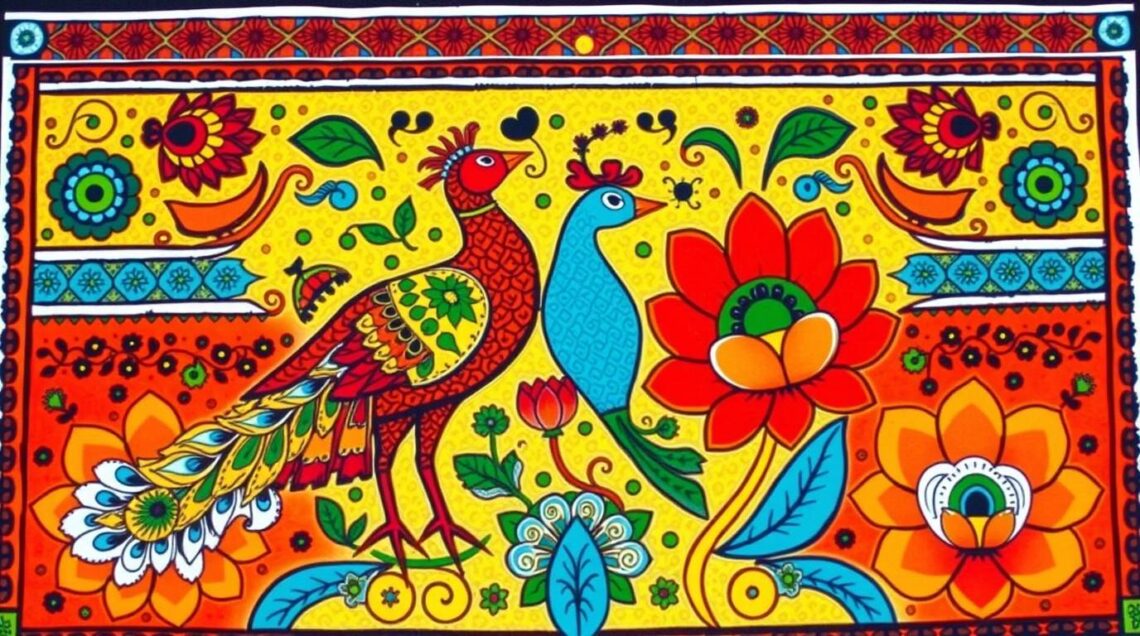
Madhubani Art Painting: History, Styles, and Techniques Explained
India’s folk art traditions are a vibrant tapestry of colors, stories, and cultural heritage. Among these, Madhubani art painting—also known as Mithila painting—stands out for its intricate patterns, symbolic storytelling, and handmade charm. Originating from the Mithila region of Bihar, Madhubani art has been passed down through generations, primarily by women, who created these paintings on walls and floors as part of religious rituals, festivals, and social ceremonies. Over time, this tradition evolved into Madhubani Handmade painting on paper, canvas, and other mediums, bringing the art form to a global audience.
Artists such as Dulari Devi have been instrumental in preserving and promoting Madhubani painting. Through exhibitions, workshops, and mentorship, they have ensured that the traditional techniques and cultural essence of the art are maintained while inspiring new generations of artists worldwide.
Historical Origins of Madhubani Art
Madhubani art traces its roots back over 2,500 years to the Mithila region, a cultural and historical hub in northern Bihar. Originally, the paintings adorned the mud walls and floors of village homes, created during significant events such as weddings, festivals, and religious ceremonies. The art was more than decorative—it served as a medium for storytelling, spiritual expression, and the preservation of cultural knowledge.
The themes of these paintings often centered around Hindu mythology, including the Ramayana and Mahabharata, as well as depictions of gods and goddesses such as Krishna, Shiva, Durga, and Ganesha. Natural elements—trees, birds, fish, the sun, and the moon—were also common, symbolizing fertility, prosperity, and harmony with nature.
Distinct Styles of Madhubani Painting
Madhubani painting is known for its multiple regional and stylistic variations, each reflecting the artistic sensibilities of local communities. Some of the most recognized styles include:
- Bharni Style: Characterized by vibrant, filled-in colors and detailed patterns, often used to depict deities and religious themes.
- Katchni Style: Known for its intricate line work and minimal use of color, emphasizing fine details and geometric patterns.
- Godna Style: Inspired by traditional tattoo patterns, often used for symbolic and ritualistic representations.
- Tantrik Style: Focused on esoteric and spiritual motifs, drawing inspiration from tantric rituals and symbols.
Each style demonstrates a unique approach to composition, color, and symbolism, highlighting the diversity within the Madhubani tradition.
Techniques in Madhubani Handmade Painting
The techniques used in Madhubani Handmade painting are central to its identity. Traditionally, artists created the paintings on walls prepared with a layer of mud and cow dung to provide a smooth surface. Natural pigments were used for coloring: black from soot, red from powdered brick, yellow from turmeric, green from leaves, and blue from indigo.
Tools varied from fingers and twigs to brushes and bamboo sticks, allowing for precision and intricate detailing. One of the hallmark techniques is “bharai”, or filling, where every empty space in the painting is filled with fine lines, dots, or geometric patterns. This approach creates visual rhythm and density, making the composition appear vibrant and cohesive.
Modern Madhubani paintings on paper, canvas, and fabric continue to follow these traditional techniques, maintaining the authenticity of the art while making it portable and accessible to a wider audience. Artists like Dulari Devi ensure that learners and enthusiasts understand both the technical execution and the symbolic meanings behind each motif.
Symbolism and Cultural Significance
Madhubani art is deeply symbolic, with each motif conveying meaning. Geometric patterns often frame deities, animals, or natural elements, enhancing the visual narrative. Birds, fish, and animals signify prosperity and harmony, while floral patterns and vines represent fertility and abundance.
Human figures are usually two-dimensional, drawn in profile with expressive gestures to depict dancing, farming, or ritual activities. These scenes reflect the collective spirit of the community and celebrate daily life, festivals, and spiritual devotion.
The symbolic richness of Madhubani paintings makes them more than decorative objects—they are cultural archives, preserving the traditions, rituals, and beliefs of the Mithila region for future generations.
Role of Women in Madhubani Art
Traditionally, Madhubani painting was a female-dominated art form. Women created these works as part of household rituals and ceremonies, passing down techniques and styles through generations. The art provided a creative outlet for self-expression, storytelling, and spiritual engagement.
In contemporary times, women continue to dominate the Madhubani art scene, although male artists have also become active contributors. Figures like Dulari Devi have played a significant role in elevating Madhubani art to national and international recognition. Their efforts have preserved the authenticity of traditional techniques while expanding the reach and appreciation of this folk art globally.
Modern Applications and Global Recognition
While Madhubani art originated as a domestic and ritual practice, its intricate patterns and vibrant colors have made it highly adaptable to contemporary contexts. Today, Madhubani motifs are used in wall murals, home decor, textiles, fashion, stationery, and even digital media. This versatility allows the art to maintain its cultural identity while appealing to modern design sensibilities.
The global recognition of Madhubani art has been further enhanced by workshops, exhibitions, and educational initiatives. Artists like Dulari Devi have played a vital role in sharing the art with international audiences, promoting cultural exchange, and inspiring appreciation for the traditional craft.
Challenges and Preservation Efforts
Despite its popularity, Madhubani art faces challenges such as commercialization, imitation, and dilution of traditional techniques. To preserve authenticity, it is essential to maintain the handmade nature of the work, the use of natural pigments, and the symbolic meanings embedded in each painting.
Educational initiatives and workshops led by experienced artists ensure that learners understand both the techniques and the cultural context of Madhubani painting. By teaching traditional methods and encouraging respect for the art’s heritage, these programs help safeguard Madhubani as a living cultural tradition while enabling new interpretations and contemporary applications.
Why Madhubani Art Stands Out
Madhubani art is unique among Indian folk arts for its combination of handmade authenticity, intricate detailing, symbolic depth, and vibrant colors. Unlike decorative art forms that prioritize aesthetics alone, Madhubani painting communicates narratives, spiritual devotion, and cultural values. Its geometric patterns, repetitive motifs, and dense compositions create a visual language that is instantly recognizable and universally admired.
Moreover, the adaptability of Madhubani art—transitioning from walls to paper, canvas, and textiles—ensures its continued relevance in the modern world. The dedication of artists like Dulari Devi guarantees that this rich folk tradition is preserved, celebrated, and shared globally without losing its essence.
Conclusion
Madhubani art painting is a testament to India’s rich folk heritage, combining history, symbolism, and meticulous craftsmanship. Its distinct styles, vibrant colors, and handmade techniques make it a truly unique form of artistic expression. As a Madhubani Handmade painting, it preserves centuries of cultural knowledge and tradition, offering insight into the daily life, rituals, and spiritual practices of the Mithila region.
Through the work of master artists like Dulari Devi, Madhubani art continues to thrive, gaining recognition on national and international platforms. By teaching traditional techniques and symbolic meanings, these artists ensure that Madhubani painting remains a living, evolving art form.
Its timeless appeal, cultural depth, and adaptability make Madhubani art not just a visual delight but also an enduring legacy of India’s folk creativity. Appreciating and supporting this art form means celebrating centuries of history, devotion, and human creativity, ensuring that Madhubani painting continues to inspire generations around the world.
You May Also Like

Powerful Tips To Ace The SSC Exams 
February 9,
How Much Does It Cost To Hire Remote Flutter Developers?
September 7,

